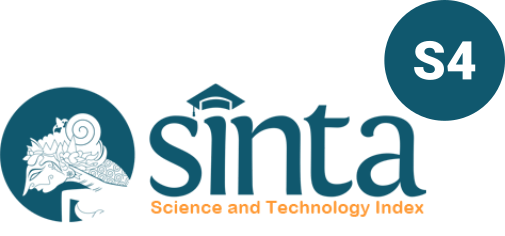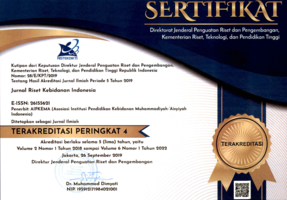Title:
Inisiasi menyusu dini (IMD) sebagai upaya awal pemberian ASI eksklusif: scoping review
Author:
Abstract
Latar belakang: ASI merupakan makanan terbaik bagi bayi yang dapat mendukung tumbuh kembang dan kesehatan bayi. Terdapat berbagai manfaat dari ASI dan ASI eksklusif bagi bayi dan masa depannya. Salah satu faktor yang mempengaruhi keberhasilan ASI eksklusif adalah inisiasi menyusu dini (IMD). Tujuan penelitian: Tujuan dari tinjauan literatur ini adalah untuk mengidentifikasi bukti-bukti yang tersedia dari literatur terkini terkait hubungan IMD dan ASI eksklusif. Metode: Tinjauan literatur ini menggunakan metode scoping review, dengan tahapan mengidentifikasi pertanyaan penelitian, mengidentifikasi artikel yang relevan, menyeleksi artikel, memetakan data serta menyusun, meringkas, dan melaporkan hasil. Hasil: Dari hasil seleksi akhir, didapatkan 18 artikel yang sesuai. Sebanyak 17 artikel menggunakan desain penelitian kuantitatif dan 1 artikel menggunakan mix method. Lokasi penelitian termasuk beberapa negara yaitu China, Jepang, Indonesia, India, Sri Lanka, Arab Saudi, Ethiopia, Nigeria, dan beberapa negara di Afrika lainnya. Sebagian besar artikel menunjukkan adanya hubungan antara IMD dan ASI eksklusif. Simpulan: IMD merupakan faktor yang mempengaruhi ASI eksklusif. IMD setelah persalinan diperlukan sebagai upaya untuk melanjutkan keberlangsungan pemberian ASI ekslusif hingga enam bulan.
Keywords
Full Text:
PDFReferences
Aksamala, R. C., Widjanarko, B., & Suginatono, A. (2018). Beberapa Faktor Yang Mempengaruhi Praktik Ibu Dalam Pemberian Asi Eksklusif Di Wilayah Kerja Puskesmas Pegandan Kota Semarang. Jurnal Kesehatan Masyarakat (e-Journal), 6(5), 788–794.
Al Shahrani, A. S. (2022). Does COVID-19 Policy Affect Initiation and Duration of Exclusive Breastfeeding? A Single-center Retrospective Study. Risk Management and Healthcare Policy, 15(December 2021), 27–36. https://doi.org/10.2147/RMHP.S343150
Appiah, P. K., Amu, H., Osei, E., Konlan, K. D., Mumuni, I. H., Verner, O. N., … Kim, S. Y. (2021). Breastfeeding and weaning practices among mothers in Ghana: A population-based cross-sectional study. PLoS ONE, 16(11 November), 1–20. https://doi.org/10.1371/journal.pone.0259442
Arksey, H., & O’Malley, L. (2005). Scoping studies: Towards a methodological framework. International Journal of Social Research Methodology: Theory and Practice, 8(1), 19–32. https://doi.org/10.1080/1364557032000119616
Atimati, A. O., & Adam, V. Y. (2020). Breastfeeding practices among mothers of children aged 1–24 months in Egor Local Government Area of Edo State, Nigeria. South African Journal of Clinical Nutrition, 33(1), 10–16. https://doi.org/10.1080/16070658.2018.1493071
Benova, L., Siddiqi, M., Abejirinde, I. O. O., & Badejo, O. (2020). Time trends and determinants of breastfeeding practices among adolescents and young women in Nigeria, 2003-2018. BMJ Global Health, 5(8). https://doi.org/10.1136/bmjgh-2020-002516
Breevoort, D. Van, Tognon, F., Beguin, A., Ngegbai, A. S., & Putoto, G. (2021). Determinants of breastfeeding practice in Pujehun district , southern Sierra Leone : a mixed-method study. 4, 1–13.
Daher, S., Ziade, F., Nasreddine, L., Baroudi, M., & Naja, F. (2022). Breastfeeding and complementary feeding in fragile settings: the case of Syrian refugees and their host communities in North Lebanon. International Breastfeeding Journal, 17(1), 1–15. https://doi.org/10.1186/s13006-022-00480-x
Duarte Lopes, E., Monteiro, A. M. R. L., Varela, D. O. B. F. C., Trigueiros, D. E. L. R., Monteiro Spencer Maia, I., de Jesus Xavier Soares, J., & da Luz Pires Vieira, N. M. (2022). The prevalence of exclusive breastfeeding and its associated factors in Cape Verde. BMC Nutrition, 8(1), 1–8. https://doi.org/10.1186/s40795-022-00554-3
Fikawati, S., Syafiq, A., & Karima, K. (2015). Gizi Ibu dan Bayi. Jakarta: Rajagrafindo Persada.
Horta, B. L., & Victora, C. G. (2013). Long-term effects of breastfeeding: a systematic review. Geneva: World Health Organization. Diambil dari https://apps.who.int/iris/handle/10665/79198
Hossain, M., Islam, A., Kamarul, T., & Hossain, G. (2018). Exclusive breastfeeding practice during first six months of an infant’s life in Bangladesh: A country based cross-sectional study. BMC Pediatrics, 18(1), 1–9. https://doi.org/10.1186/s12887-018-1076-0
Inano, H., Kameya, M., Sasano, K., Matsumura, K., Tsuchida, A., Hamazaki, K., … Katoh, T. (2021). Factors influencing exclusive breastfeeding rates until 6 months postpartum: the Japan Environment and Children’s Study. Scientific Reports, 11(1), 1–12. https://doi.org/10.1038/s41598-021-85900-4
Jebena, D. D., & Tenagashaw, M. W. (2022). Breastfeeding practice and factors associated with exclusive breastfeeding among mothers in Horro District, Ethiopia: A community-based cross-sectional study. PLoS ONE, 17(4 April), 1–17. https://doi.org/10.1371/journal.pone.0267269
Joseph, R., John, J. J., David, A., Sankar, L., Darvin, D., & Yashik, M. (2022). Potential Determinants and Effects of Exclusive Breastfeeding Among Infants at a Tertiary Care Center, Kerala, India. Cureus, 14(3), 1–8. https://doi.org/10.7759/cureus.23185
Li, J., Zhao, C., Wang, Y., Wang, Y. P., Chen, C. Y., Huang, Y., … Zhou, H. (2021). Factors associated with exclusive breastfeeding practice among mothers in nine community health centres in Nanning city, China: a cross-sectional study. International Breastfeeding Journal, 16(1), 1–15. https://doi.org/10.1186/s13006-021-00416-x
Maryunani, A. (2012). Inisiasi Menyusu Dini, ASI Eksklusif dan Manajemen Laktasi. Jakarta: CV. Trans Info Media.
Mekebo, G. G., Argawu, A. S., Likassa, H. T., Ayele, W., Wake, S. K., Bedada, D., … Diriba, G. (2022). Factors influencing exclusive breastfeeding practice among under-six months infants in Ethiopia. BMC Pregnancy and Childbirth, 22(1), 1–11. https://doi.org/10.1186/s12884-022-04955-x
Mulatu Dibisa, T., & Sintayehu, Y. (2020).
Exclusive Breast Feeding and Its Associated Factors Among Mothers of <12 Months Old Child in Harar Town, Eastern Ethiopia: A Cross-Sectional Study
. Pediatric Health, Medicine and Therapeutics, Volume 11, 145–152. https://doi.org/10.2147/phmt.s253974Nuraini, T., Julia, M., & Dasuki, D. (2013). Sampel Susu Formula dan Praktik Pemberian Air Susu Ibu Eksklusif. Kesmas: National Public Health Journal, 7(12), 551. https://doi.org/10.21109/kesmas.v7i12.329
Okanda, J., Otieno, G., Kinuthia, J., Kohler, P., & John-Stewart, G. (2018). Higher likelihood of 6-months exclusive breastfeeding among HIV infected than uninfected mothers: A household survey in Kenya. International Breastfeeding Journal, 13(1), 1–8. https://doi.org/10.1186/s13006-018-0190-9
Oyelana, O., Kamanzi, J., & Richter, S. (2021). A critical look at exclusive breastfeeding in Africa: Through the lens of diffusion of innovation theory. International Journal of Africa Nursing Sciences, 14, 100267. https://doi.org/10.1016/j.ijans.2020.100267
Peters, M. D. J., Godfrey, C. M., Khalil, H., McInerney, P., Parker, D., & Soares, C. B. (2015). Guidance for conducting systematic scoping reviews. International Journal of Evidence-Based Healthcare, 13(3), 141–146. https://doi.org/10.1097/XEB.0000000000000050
Ratnayake, H. E., & Rowel, D. (2018). Prevalence of exclusive breastfeeding and barriers for its continuation up to six months in Kandy district, Sri Lanka. International Breastfeeding Journal, 13(1), 1–9. https://doi.org/10.1186/s13006-018-0180-y
Ruan, Y., Zhang, Q., Li, J., Wan, R., Bai, J., Wang, W., … Liu, Z. (2019). Factors associated with exclusive breastfeeding: A cross-sectional survey in Kaiyuan, Yunnan, Southwest China. PLoS ONE, 14(10), 1–11. https://doi.org/10.1371/journal.pone.0223251
Sankar, M. J., Sinha, B., Chowdhury, R., Bhandari, N., Taneja, S., Martines, J., & Bahl, R. (2015). Optimal breastfeeding practices and infant and child mortality: A systematic review and meta-analysis. Acta Paediatrica, International Journal of Paediatrics, 104, 3–13. https://doi.org/10.1111/apa.13147
Shi, H., Yang, Y., Yin, X., Li, J., Fang, J., & Wang, X. (2021). Determinants of exclusive breastfeeding for the first six months in China: a cross-sectional study. International Breastfeeding Journal, 16(1), 1–13. https://doi.org/10.1186/s13006-021-00388-y
Shofiya, D., Sumarmi, S., & Ahmed, F. (2020). Nutritional status, family income and early breastfeeding initiation as determinants to successful exclusive breastfeeding. Journal of Public Health Research, 9(2), 110–112. https://doi.org/10.4081/jphr.2020.1814
Tongun, J. B., Tumwine, J. K., Ndeezi, G., Sebit, M. B., Mukunya, D., Nankunda, J., & Tylleskar, T. (2019). The effect of health worker training on early initiation of breastfeeding in south Sudan: A hospital-based before and after study. International Journal of Environmental Research and Public Health, 16(20). https://doi.org/10.3390/ijerph16203917
Victora, C. G., Bahl, R., Barros, A. J. D., França, G. V. A., Horton, S., Krasevec, J., … Rollins, N. C. (2016). Breastfeeding in the 21st century: Epidemiology, mechanisms, and lifelong effect. The Lancet, 387(10017), 475–490. https://doi.org/10.1016/S0140-6736(15)01024-7
WHO. (2021). Infant and young child feeding. Diambil 2 September 2022, dari https://www.who.int/news-room/fact-sheets/detail/infant-and-young-child-feeding
WHO, & UNICEF. (2021). Indicators for Assessing Infant and Young Child Feeding Practices. Geneva: World Health Organization. Diambil dari http://whqlibdoc.who.int/publications/2010/9789241599757_eng.pdf
Wu, X., Gao, X., Sha, T., Zeng, G., Liu, S., Li, L., … Yan, Y. (2019). Modifiable individual factors associated with breastfeeding: A cohort study in China. International Journal of Environmental Research and Public Health, 16(5). https://doi.org/10.3390/ijerph16050820
DOI: https://doi.org/10.32536/jrki.v6i2.221
Article Metrics
Abstract view : 6905 timesPDF - 2618 times
Cited By
Refbacks
- There are currently no refbacks.
Copyright (c) 2022 Jurnal Riset Kebidanan Indonesia

This work is licensed under a Creative Commons Attribution-ShareAlike 4.0 International License.
Jurnal Riset Kebidanan Indonesia
Indexing by:
Diterbitkan oleh:
AIPKEMA (Asosiasi Institusi Pendidikan Kebidanan Muhammadiyah-'Aisyiyah Indonesia)
Universitas ‘Aisyiyah Yogyakarta, Jl. Siliwangi (Ring Road Barat) No. 63, Nogotirto, Gamping, Sleman, Yogyakarta 55292.
Telp. (0274) 4469199; CP: 081236093816; Email: aipkemajrki@gmail.com; dewik.2011@gmail.com

This work (Jurnal Riset Kebidanan Indonesia) is licensed under a Creative Commons Attribution-ShareAlike 4.0 International License.










 Abstract views : 6905
|
Abstract views : 6905
| PDF views : 2618
PDF views : 2618


